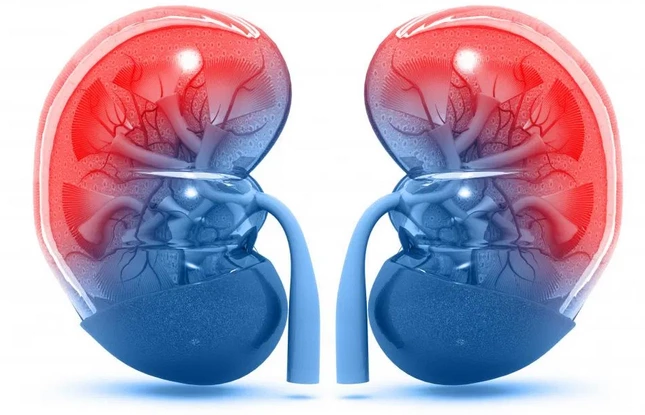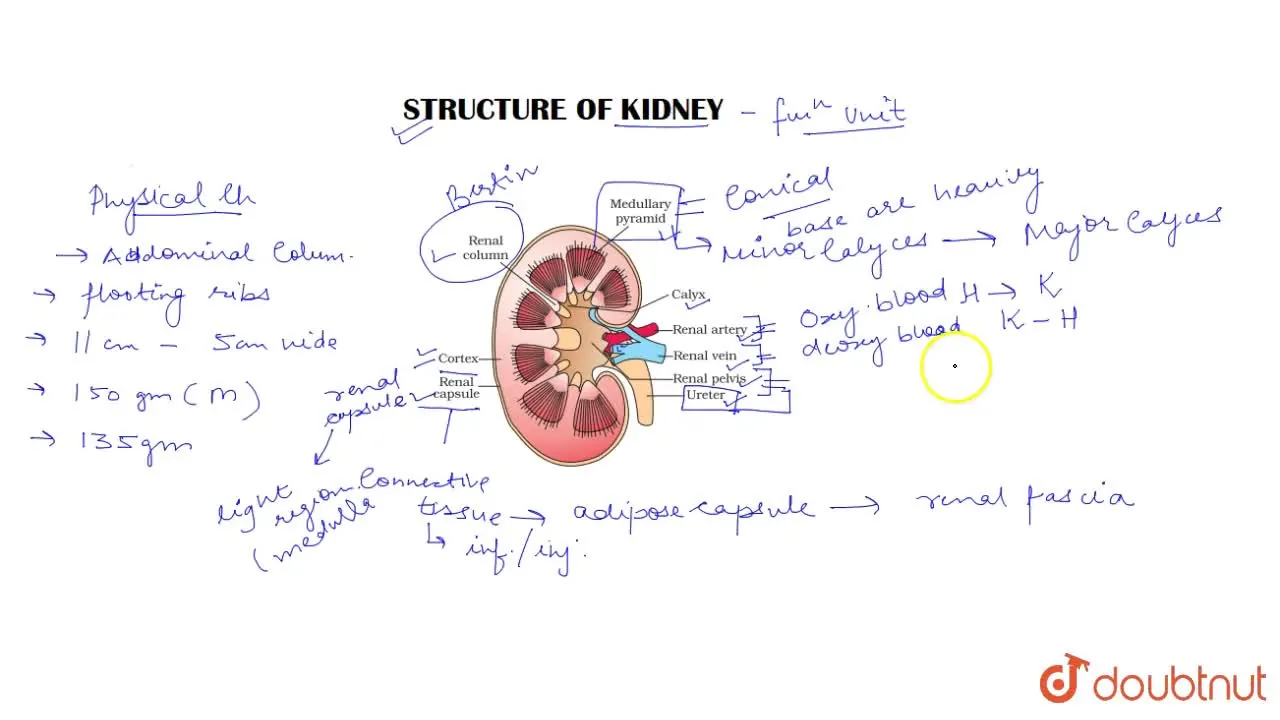Kidney
Kidney
In this chapter we will discuss the kidney and its function. We will also focus on the symptoms of kidney problems.
Kidneys are bean-shaped structures that are present in all vertebrates. It is located on either side of the backbone. Its main function is to remove waste products from the body. It also helps to regulate blood pressure and maintain balanced electrolyte levels. There is a notch called hilum at the centre through which nerves and blood vessels enter the organ. There is also a large funnel-shaped space towards the inner surface of the hilum, which is known as renal pelvis.

Structure of Kidney
We will now explain the structure of the kidney
-
Capsule: The capsule is the outer layer of the kidney. There are two zones inside the kidney – the inner zone is medulla, and the outer zone is the cortex. Between the medullary pyramids, there is the cortex which is called columns of Bertin.
-
Nephrons: Nephrons are the functional units of the kidney. There are two parts in each nephron which are glomerulus and renal tubule. In the glomerulus, there is a bunch of capillaries that are formed by afferent arterioles. When it comes to the renal tubule, it starts with a cup-like structure which is known as Bowman’s capsule. The proximal convoluted tubule is the tubule next to Bowman’s capsule. It is a highly coiled structure that is present in it.
-
Henle’s loop: Henle’s loop is the next part of the tubule, which has an ascending and a descending limb. Regarding the ascending loop, it continues as a distal convoluted tubule. The many nephrons of the distal convoluted tubules open into the collecting duct. The proximal convoluted tubule, malpighian corpuscle, and distal convoluted tubule are comprised of the cortical region of the kidney. Cortical and juxtamedullary are the two types of nephrons. Here, the loop of Henle is found to be very short in the case of cortical, which extends only a little into the medulla. Coming to the juxtamedullary, the loop of Henle is very long, which runs deep into the medulla.
-
Ureter: It is a thin muscular tube that comes out of each kidney that extends from the renal pelvis. Here, urine is carried from the kidney to the urinary bladder.
-
Urinary bladder: The function of the urinary bladder is to store urine until micturition. Here the expulsion of urine from the body is termed as micturition. The urinary bladder is a sac-like structure. It is through the ureters that the urine is carried to the bladder.
-
Urethra: This is a tube that arises from the urinary bladder that helps in expelling urine out of the body.
What are the Symptoms of kidney Problems?
There are many adults that are living with kidney disease but are unaware of it. It should be noted that there several symptoms of kidney diseases. When people come to know at the later stage, it becomes too late. So, it is quite important for you to get the best information on how to get to know the symptoms that occur. You need to make sure of getting your kidney tested once in a year.
-
Trouble concentrating: When there is a severe decrease in the function of the kidney, toxins are built up, which also leads to impurities in the blood. So, this leads people to feel weak and tired, that makes them hard to concentrate. In some cases, it might also lead to anaemia that causes fatigue and weakness.
-
Trouble sleeping: Toxins stay in the blood because the kidneys do not get filtered properly. So, it does not leave the body through the urine. This, in turn, leads to making it difficult to get a good sleep. Sleep apnea is more common for people suffering from kidney problems.
-
Dry and itchy skin: As mentioned earlier, the kidney does a lot of important jobs. It helps in making red blood cells and also removes wastes and extra fluid from your body. People facing problems with kidney leads to dry and itchy skin. This happens because of the reason for the inability of the kidney to keep the right balance of nutrients and minerals in your blood. It also leads to puffiness around your eyes as well.
-
The need to urinate more often: Another sign of kidney disease is the need to urinate more often. In other words, it causes an increase in the urge to urinate more. However, in some cases, this can also be due to the enlarged prostate or urinary infection in men.
-
Blood in the urine: When the filters of the kidney get damaged the blood cells in the body starts to leak out into the urine. So, blood in the urine indicates kidney stones, tumours, or even an infection.
-
Urine becomes foamy: If protein leaks into the urine, it becomes foamy. So, if you find excessive bubbles in the urine even after flushing a lot of time, then this indicates that you have a problem with your kidney. The foam that you can see resembles the same as that of scrambled eggs.
-
Ankles and feet are swollen: The decrease in the function of the kidney also leads to sodium retention, which causes your ankle and feet to swell. If you notice a swelling in the lower extremities, then this can be a sign of heart disease or liver disease.
-
Poor appetite: Loss of appetite is another sign of a poor kidney function. It builds up toxins that lead to this condition. People suffering from kidney problems lack the taste of food and the craving for the same also decreases.
-
Cramping of muscles: Impaired kidney function results in electrolyte imbalance. This leads to cramping of muscles because of low levels of calcium as well as poorly controlled phosphorous.
Thus taking care of your kidney is very important to maintain overall health. In case you feel any symptoms that have been mentioned above, it is necessary to consult a doctor.
Important Chapters:

Capsule: The capsule is the outer layer of the kidney. There are two zones inside the kidney – the inner zone is medulla, and the outer zone is the cortex. Between the medullary pyramids, there is the cortex which is called columns of Bertin.
Nephrons: Nephrons are the functional units of the kidney. There are two parts in each nephron which are glomerulus and renal tubule. In the glomerulus, there is a bunch of capillaries that are formed by afferent arterioles. When it comes to the renal tubule, it starts with a cup-like structure which is known as Bowman’s capsule. The proximal convoluted tubule is the tubule next to Bowman’s capsule. It is a highly coiled structure that is present in it.
Henle’s loop: Henle’s loop is the next part of the tubule, which has an ascending and a descending limb. Regarding the ascending loop, it continues as a distal convoluted tubule. The many nephrons of the distal convoluted tubules open into the collecting duct. The proximal convoluted tubule, malpighian corpuscle, and distal convoluted tubule are comprised of the cortical region of the kidney. Cortical and juxtamedullary are the two types of nephrons. Here, the loop of Henle is found to be very short in the case of cortical, which extends only a little into the medulla. Coming to the juxtamedullary, the loop of Henle is very long, which runs deep into the medulla.
Ureter: It is a thin muscular tube that comes out of each kidney that extends from the renal pelvis. Here, urine is carried from the kidney to the urinary bladder.
Urinary bladder: The function of the urinary bladder is to store urine until micturition. Here the expulsion of urine from the body is termed as micturition. The urinary bladder is a sac-like structure. It is through the ureters that the urine is carried to the bladder.
Urethra: This is a tube that arises from the urinary bladder that helps in expelling urine out of the body.
Trouble concentrating: When there is a severe decrease in the function of the kidney, toxins are built up, which also leads to impurities in the blood. So, this leads people to feel weak and tired, that makes them hard to concentrate. In some cases, it might also lead to anaemia that causes fatigue and weakness.
Trouble sleeping: Toxins stay in the blood because the kidneys do not get filtered properly. So, it does not leave the body through the urine. This, in turn, leads to making it difficult to get a good sleep. Sleep apnea is more common for people suffering from kidney problems.
Dry and itchy skin: As mentioned earlier, the kidney does a lot of important jobs. It helps in making red blood cells and also removes wastes and extra fluid from your body. People facing problems with kidney leads to dry and itchy skin. This happens because of the reason for the inability of the kidney to keep the right balance of nutrients and minerals in your blood. It also leads to puffiness around your eyes as well.
The need to urinate more often: Another sign of kidney disease is the need to urinate more often. In other words, it causes an increase in the urge to urinate more. However, in some cases, this can also be due to the enlarged prostate or urinary infection in men.
Blood in the urine: When the filters of the kidney get damaged the blood cells in the body starts to leak out into the urine. So, blood in the urine indicates kidney stones, tumours, or even an infection.
Urine becomes foamy: If protein leaks into the urine, it becomes foamy. So, if you find excessive bubbles in the urine even after flushing a lot of time, then this indicates that you have a problem with your kidney. The foam that you can see resembles the same as that of scrambled eggs.
Ankles and feet are swollen: The decrease in the function of the kidney also leads to sodium retention, which causes your ankle and feet to swell. If you notice a swelling in the lower extremities, then this can be a sign of heart disease or liver disease.
Poor appetite: Loss of appetite is another sign of a poor kidney function. It builds up toxins that lead to this condition. People suffering from kidney problems lack the taste of food and the craving for the same also decreases.
Cramping of muscles: Impaired kidney function results in electrolyte imbalance. This leads to cramping of muscles because of low levels of calcium as well as poorly controlled phosphorous.


